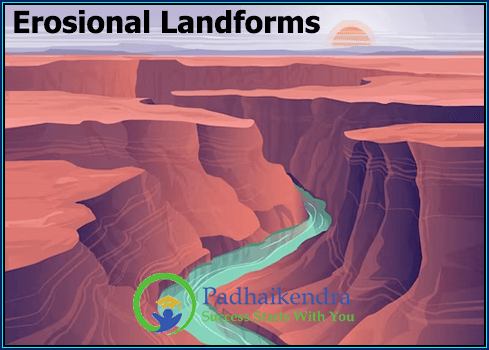Erosional landforms are features created by the process of erosion, which is the gradual wearing away of the Earth’s surface by natural forces such as water, wind, and ice. Erosion can shape the land in a variety of ways, creating unique and striking landforms that are often admired for their natural beauty.
Here are some examples of erosional landforms:
- Canyons: Canyons are deep, narrow valleys carved by rivers or streams over millions of years. The steep walls of the canyon are often made of hard, resistant rock, while the floor of the canyon is formed by softer, more easily eroded rock. Some of the most famous canyons in the world include the Grand Canyon in the United States and the Colca Canyon in Peru.
- Valleys: Valleys are long, narrow depressions in the Earth’s surface, often created by rivers or glaciers. They can be V-shaped or U-shaped, depending on the type of erosion that created them. Valleys can also be formed by tectonic activity, such as the movement of plates along a fault line. Examples of famous valleys include the Yosemite Valley in the United States and the Rhine Valley in Europe.
- Caves: Caves are underground chambers and passages created by the erosion of rock by water over long periods of time. Water can dissolve limestone and other soluble rocks, creating a network of tunnels and caverns. Stalactites and stalagmites, formed by the slow dripping of water, are common features of caves. Some famous caves include the Carlsbad Caverns in the United States and the Waitomo Caves in New Zealand.
- Archs: Arches are natural rock formations that have been eroded by wind and water over time. They are often found in areas of sedimentary rock, where layers of rock have been eroded at different rates, leaving behind a unique shape. Some of the most famous arches in the world include Delicate Arch in Arches National Park in the United States and Durdle Door in England.
- Hoodoos: Hoodoos are tall, thin spires of rock that are formed by erosion. They are often found in desert regions, where wind and water have eroded the soft rock around a harder, more resistant rock formation, leaving behind a tall spire. The most famous examples of hoodoos are found in Bryce Canyon National Park in the United States.
Overall, erosional landforms are a testament to the power of natural forces to shape the Earth’s surface over time. They provide a glimpse into the history of the planet and remind us of the importance of preserving these natural wonders for future generations to enjoy.





